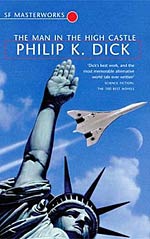
![]() Grayman14
Grayman14
11/5/2016
![]()
"On some other world, possibly it is different. Better. There are clear good and evil alternatives. Not these obscure admixtures, these blends, with no proper tool by which to untangle the components." (p.227)
Often considered to be Dick's best work, as well as his most mainstream, The Man in the High Castle imagines a future in which Germany, Italy and Japan won the Second World War. America is occupied by both the Germans and the Japanese. The story concentrates on events occurring in California, now part of the 'Pacific States of America' controlled by the Japanese. As is common in a lot of Dick's writing, ordinary people dealing with unusual or extraordinary events are the focal point of TMITHC.
These everyday people make up the main characters of the book. Thus we meet Mr. Tagomi, a Japanese trade official, Bob Childan, an antiques dealer, Frank Frink, a jewelry maker, Frink's ex-wife Juliana, a judo instructor, and Joe Cinnadella, a truck driver. In the background lurks Hawthorne Abendsen, the author of an alternative history novel popular at the time, despite it being banned by the Nazis. 'The Grasshopper Lies Heavy' is a book within a book, an alternative history within an alternative history. Dick soon has everyone questioning what is real...
Instead of a standard review, I have used excerpts from interviews with Dick regarding this novel. I wanted to offer some glimpses as to what the author thought about it. It is the only novel by Dick to win a Hugo Award.
"I started with nothing but the name "Mister Tagomi" written on a scrap of paper, no other notes. I had been reading a lot of Oriental philosophy, reading a lot of Zen Buddhism, reading the I Ching. That was the Marin County zeitgeist at that point, Zen Buddhism and the I Ching."
(Philip K. Dick, in his final interview with Rod Sterling's The Twilight Zone Magazine, June 1982)
"To me the great joy in writing a book is showing some small person, some ordinary person doing something in a moment of great valor, for which he would get nothing and which would be unsung in the real world. The book, then, is the song about his valor. You know, people think that the author wants to be immortal, to be remembered through his work. No. I want Mr. Tagomi from The Man in the High Castle always to be remembered. My characters are composites of what I've actually seen people do, and the only way for them to be remembered is through my books."
(Philip K. Dick, in an interview with Arthur Byron Cover, February 1974.)
In 1968, Dick wrote a letter to the Japanese translator of the book posing a number of questions: ...
[*Please click the link below if you want to read the rest of this letter*]
I enjoyed TMITHC. It wasn't quite the "Masterwork" I had expected it to be, but it was a fascinating story, one which I feel I need to read again to fully appreciate. Dick's use of the Book of Changes, or I Ching, made for an interesting plot device, especially having a Japanese character consulting it with such reverence. And the book within the book offering an alternative to the alternative history was, for me, a stroke of genius. Perhaps The Man in the High Castle is the "true" story and we are all stuck in the fictional reality of Abendsen's 'The Grasshopper Lies Heavy'.
https://biginjapangrayman.wordpress.com/2016/09/25/the-man-in-the-high-castle-1963-by-philip-k-dick/